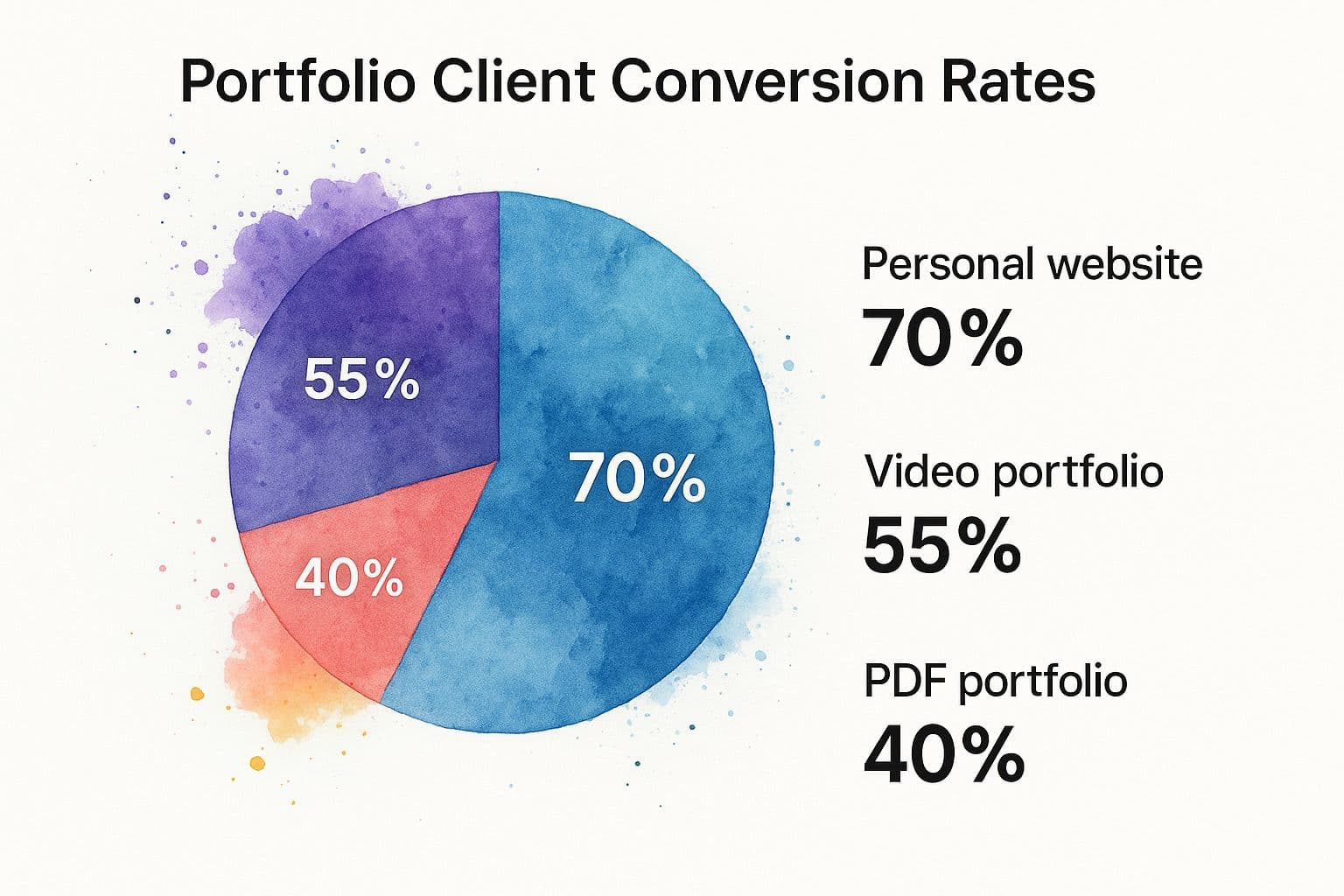Learn how to become a virtual assistant with our expert guide. Discover essential skills, tools, and strategies to start your VA business today!
July 13, 2025 (5mo ago)
How to Become a Virtual Assistant: 7 Easy Steps to Success
Learn how to become a virtual assistant with our expert guide. Discover essential skills, tools, and strategies to start your VA business today!
← Back to blog
Becoming a virtual assistant is an incredibly achievable career path. It’s not about starting from scratch but about repackaging the skills you already have into a service that businesses desperately need. The whole journey boils down to identifying what you're good at, setting yourself up professionally, and then going out to find clients who need you.
Your Roadmap to Becoming a Virtual Assistant
The demand for talented virtual assistants is exploding. Seriously. The global virtual assistant market is on track to jump from $6.37 billion to over $19.66 billion by 2029**. That’s not just growth; it's a massive wave of opportunity for anyone looking to step into this field.
This guide isn't just about finding another remote job—it's about building a real business. True success comes from blending your unique talents with savvy business practices. If you want to dive deeper into the business mechanics, our complete guide on how to start a virtual assistant business is the perfect next step.
Embracing the Mindset Shift
Stepping into the VA world requires a fundamental shift in how you think about work. You’re no longer an employee waiting for instructions; you are the CEO of your own company. You're in charge of everything—from marketing yourself to keeping your clients happy.
The core principle of entrepreneurship is having the freedom to run your business exactly how you want. What feels good to one person may not align with another, and that's the whole point.
If this feels like a big leap from your current career, that's completely normal. You might find some helpful advice in these general career change tips to manage the transition.
Before we dive deep, let's get a bird's-eye view of the launch process. This checklist breaks down the essential first moves you'll need to make to get your VA career off the ground.
Quick Start Checklist for Aspiring Virtual Assistants
| Phase | Key Action | Why It Matters |
|---|---|---|
| Foundation | Identify Your Marketable Skills | You need to know what you're selling. This builds your service offerings and defines your ideal client. |
| Setup | Establish a Business Presence | This makes you look professional and trustworthy. It includes your business name, services, and pricing. |
| Growth | Learn Client Acquisition Strategies | You can have the best skills in the world, but you need paying clients to have a business. |
| Operations | Create Your Service Delivery Workflow | This ensures you deliver high-quality work efficiently, leading to happy clients and great referrals. |
Think of this table as your initial flight check. Nailing these items sets you up for a much smoother journey ahead.
Key Pillars of Your VA Journey
Your path to becoming a successful virtual assistant stands on a few core pillars. Get these right, and you'll build a business with a solid foundation that can last for years.
-
Skill Identification: First, you have to figure out what you're selling. It’s about looking at your past experience—whether it’s managing calendars, writing emails, or scheduling social media posts—and seeing which of those skills are in high demand right now.
-
Business Setup: This is where you make it official. Think of a business name, create a clear menu of services you'll offer, and map out a simple plan for how you’ll operate day-to-day.
-
Client Acquisition: You need clients to have a business. This pillar is all about learning modern, effective ways to find people who need your help, pitch your services confidently, and sign them on.
-
Service Delivery: Once you have clients, you have to deliver. This means setting up simple systems to manage your projects, communicate professionally, and produce work so good that your clients stick around and tell their friends about you.
Find Your Niche and Stop Competing on Price

Here's a hard truth I learned early on: trying to be a jack-of-all-trades is the fastest way to get stuck with low-paying clients and burn out. When you offer everything to everyone, you're just another name in a sea of generalist VAs. That almost always turns into a race to the bottom on price.
The real key to commanding higher rates and attracting clients you actually want to work with is to specialize.
When you have a niche, you're not just "a VA." You become "the e-commerce VA for Shopify stores" or "the podcast launch manager for business coaches." That kind of specific positioning makes your marketing a breeze and instantly communicates your value.
Discover Your Niche "Sweet Spot"
The most profitable and enjoyable niches live at the intersection of three things: your professional experience, your genuine interests, and what the market is actually willing to pay for. Think of it as a Venn diagram, and your perfect specialty is right in the middle.
First, take a serious look at your background. What hard skills have you picked up from past jobs? If you were an executive assistant, you’ve already mastered complex calendar management and travel coordination—skills that are perfect for supporting C-suite clients. A former paralegal? You have a huge advantage with legal terminology and document management, making you a perfect fit for a small law firm.
Next, be honest about what you actually enjoy doing. You'll be spending a lot of time on these tasks, so you don't want them to feel like a chore. If you love the creative side of things, a niche in social media management or blog coordination could be a fantastic fit. If you're passionate about wellness, specializing in supporting nutritionists or fitness coaches will feel much more fulfilling.
Your niche isn't just a label; it's a strategic decision. It tells clients not just what you do, but who you do it for, instantly setting you apart from the generalist crowd.
Finally, you have to make sure there’s a real market for your idea. Do some digging. A quick search on LinkedIn or Upwork for job postings in your potential niche will show you exactly what skills businesses are paying for right now.
In-Demand VA Specializations to Consider
While your unique skills are what matter most, it helps to see what’s already working. Use these proven niches to spark ideas for your own specialized service.
-
Real Estate Support: This is way more than basic admin work. You could be managing MLS listings, coordinating showings with agents, handling client follow-up, and prepping closing documents. Your value comes from knowing the industry inside and out.
-
E-commerce Management: Online store owners are constantly overwhelmed. You can step in to manage product listings, handle customer service tickets, process orders, and run email marketing campaigns on platforms like Shopify or WooCommerce.
-
Podcast Management: This is a booming field with a ton of moving parts. As a podcast VA, you could handle everything from light audio editing and writing show notes to scheduling guests and creating promotional clips for social media.
-
Financial and Bookkeeping Support: If you have a background in finance or are great with numbers, this is a highly valuable niche. You can offer services like invoicing, expense tracking in tools like QuickBooks, and pulling together financial reports for small businesses.
The goal is to find that sweet spot where what you're good at meets a clear, urgent client need. Once you position yourself as a specialist, the conversation shifts from "What's your hourly rate?" to "How can your expertise help my business?" That change is everything.
Establish Your Professional Business Foundation

If you want clients to treat you—and pay you—like a professional, you have to operate like one from the very beginning. This is a crucial mindset shift. You're not just a freelancer picking up gigs; you're building a legitimate business. This is the real difference between a side hustle and a sustainable career.
Setting up this foundation doesn't have to be a massive undertaking. It starts with the basics, like choosing a professional business name that’s easy to remember and hints at what you do. Before you get too attached, do a quick search to make sure the name and its social media handles are available. Securing them early on creates a consistent brand from day one.
Next, think about your business structure. Most virtual assistants starting out operate as a sole proprietorship. It's the most straightforward path, as it treats you and your business as a single legal entity. While this is perfect for getting started, it's a smart move to chat with a legal or financial expert as your business grows. They can advise you on whether forming an LLC (Limited Liability Company) makes sense to give you better personal asset protection.
Crafting Your Brand Identity
Your brand is so much more than a logo or a business name. It’s the entire experience a client has with you, and a polished online presence is your first chance to build trust.
Start with your LinkedIn profile. It should scream "Virtual Assistant" and clearly state your specialization. Instead of just listing old job duties in the "About" section, tell a compelling story. Focus on the problems you solve and the value you bring to your clients. A key part of building this professional foundation is mastering the essential remote work productivity tools that clients expect you to know.
You'll also need a clearly defined menu of services. This isn't just a brain dump of every skill you have. It's a curated list of high-value solutions tailored to your ideal client. For example, a VA specializing in social media for coaches might offer:
- Content Calendar Management: Planning and scheduling posts across key platforms.
- Community Engagement: Actively responding to comments and DMs to build relationships.
- Basic Graphic Creation: Designing on-brand visuals using tools like Canva.
- Monthly Analytics Reporting: Tracking performance metrics and providing actionable insights.
Building Your Starter Portfolio
"But I don't have any clients yet!" This is a classic catch-22 for every new VA. The answer is to create your own experience with a starter portfolio filled with mock projects that show off your skills.
A portfolio isn't just proof of work; it's a demonstration of your process, your professionalism, and the quality a client can expect. Don't wait for a client to start building it.
Let's say you want to work with podcasters. Grab a public podcast episode and get to work. Create a full set of show notes, design a short audiogram for social media, and write three promotional posts for it. This gives a potential client a tangible example of exactly what you can deliver.
By taking these steps, you're doing more than just figuring out how to be a virtual assistant—you're stepping into the role of a business owner.
Price Your Services for Profitability
Figuring out what to charge is often the scariest part of launching a virtual assistant business. It's so easy to fall into the trap of undercharging, either from a lack of confidence or a fear of scaring away potential clients. But that's a direct path to burnout. Your goal isn't just to make some money; it's to build a sustainable, profitable business.
Your rate has to do more than just cover your personal salary. You're a business owner now. That means your pricing needs to account for business expenses (software, marketing, insurance), self-employment taxes (which can be a shock at 15.3% in the US), and your own profit margin. Simply copying someone else's rate without doing the math for your own situation is a rookie mistake.
Choosing Your Pricing Structure
Once you've calculated a target hourly number that covers all your bases, you need to decide how to package and sell your time. There's no one-size-fits-all answer here. The best model really depends on the kind of work you do, your niche, and what makes the most sense for your clients.
Let's break down the most common approaches.
Virtual Assistant Pricing Models Compared
Choosing the right pricing structure is key to building predictable income and strong client relationships. This table compares the most common models to help you decide which one (or which combination) works best for your VA business.
| Pricing Model | Best For | Pros | Cons |
|---|---|---|---|
| Hourly Rate | New VAs, unpredictable tasks, or clients who need flexible, ad-hoc support. | Simple to understand and implement. Ensures you're paid for all time worked. | Earning potential is capped by the number of hours you can work. Can lead to clients micromanaging your time. |
| Retainer Package | Ongoing, predictable work like social media management, email support, or general admin. | Creates stable, recurring monthly revenue. Secures your availability for the client. | Requires clear boundaries and a policy for unused hours. Can be a harder sell for new clients. |
| Project-Based Fee | Well-defined projects with a clear start and end, like a website build or a course launch. | Prices the value of the outcome, not the hours spent. Allows for higher profit margins if you're efficient. | Scope creep is a major risk if the project details aren't clearly defined upfront in a contract. |
As you can see, each model has its place. In my experience, the most successful VAs eventually blend these models. You might have a few clients on monthly retainers for consistent income, while also taking on higher-value, project-based work to boost your earnings. An hourly rate can be reserved for small, one-off tasks or consulting calls.
The Financial Habits of a Professional VA
Running a business means you have to get serious about managing your money. Start by sending professional, easy-to-read invoices as soon as the work is done. Using a simple invoicing tool like Wave or FreshBooks not only makes you look more polished but also helps you get paid faster.
This professional image extends beyond your invoices. It's about how you present your entire business.

As the data shows, having a professional website is a game-changer, leading to a 70% conversion rate. It's the most powerful tool for establishing credibility and winning a client's trust before you even speak to them. For a much deeper dive into setting your prices, check out our complete guide on virtual assistant rates.
Pro Tip: Make it a non-negotiable habit to set aside a portion of every single payment for taxes. A good rule of thumb is 25-30%. This simple step will save you from a massive financial headache and a lot of stress come tax time.
Find and Ontain Your First Paying Clients

This is what a strong, optimized profile on a major freelancing platform looks like—it’s clean, professional, and instantly shows your value. While platforms like Upwork and Fiverr are fantastic places to get your feet wet, relying on them exclusively is a rookie mistake. To build a truly sustainable business, you need a mix of strategies that put you in the driver's seat.
The good news is the demand for skilled VAs is booming. Research shows that over 70% of mid-sized and large businesses have already hired virtual assistants, and small businesses are quickly catching on. Your ideal clients are definitely out there and actively searching for the help you can provide.
Beyond the Bidding Platforms
Freelance marketplaces give you a ready-made pool of potential clients, but the real magic—and the higher rates—often happens when you build relationships on your own turf. This is how you escape the race to the bottom and stand out from the crowd.
LinkedIn should become your best friend. It’s far more than a digital resume; it’s a powerful tool for networking and finding leads. Start by polishing your profile to speak directly to your ideal client and niche. Then, get strategic about who you connect with. Think small business owners, marketing managers, or startup founders in your target industry.
Don't just connect and pitch. Engage with their posts. A thoughtful comment that adds to the conversation is infinitely more powerful than a cold, generic DM. Your goal is to get on their radar as a helpful expert long before you ever mention your services.
Another smart move is to join online communities where your ideal clients hang out. This could be niche Facebook groups, Slack channels, or industry forums. Participate authentically, answer questions, and be generous with your knowledge. When you see someone post about being overwhelmed, that’s your opening.
The Art of the Pitch and Discovery Call
Once you spot a promising lead, your pitch needs to be sharp and entirely focused on them. Please, avoid the copy-paste messages. They’re obvious and they don’t work.
A winning pitch always does these three things:
- It's Personal: Mention a specific challenge you saw them post about or a recent company win. Show you've done your homework.
- It's About Them: Frame your services as the solution to their problem, not just a laundry list of tasks you can perform.
- It Has a Clear Next Step: End with a simple, low-pressure invitation for a brief "discovery call" to explore how you could help them.
The discovery call is where you really seal the deal. Think of it less like an interview and more like a free consultation. Your main job is to listen. Ask smart, open-ended questions to dig deep into their pain points. Once you truly understand their struggles, you can confidently present your service packages as the perfect solution. It’s all about building trust and showing your value from the very first conversation.
Your first conversation with a potential client sets the tone for the entire relationship. Focus on solving their problem, not selling your service. The sale will follow naturally.
A Seamless Onboarding Experience
Congratulations, you’ve landed the client! But the work doesn’t stop there. A smooth, professional onboarding process is what turns a one-time project into a long-term partnership and glowing testimonials. This is where you prove you’re a pro.
To kick things off right, it helps to study up on client onboarding best practices. Getting your systems organized from day one is non-negotiable. Honing your understanding of project management for freelancers will make everything feel effortless for both you and your new client.
Scale Your VA Business for Long-Term Growth
Landing those first few clients is an incredible feeling, a real milestone. But let's be honest, the true goal isn't just to get clients; it's to build a business that lasts. This is where you need to shift your thinking from a freelancer trading hours for dollars to a genuine business owner focused on smart, sustainable growth. The initial hustle is one thing, but scaling your operations for the long haul requires a different strategy.
One of the most valuable things you can collect from day one is social proof. Seriously, don't be shy about this. Once you've knocked a project out of the park, ask for a testimonial. The key is timing. The best moment to ask is right after you've delivered fantastic results and your client is thrilled with your work. A simple, polite email often does the trick, and that glowing review can then be showcased on your website, LinkedIn profile, or marketing materials.
Knowing When to Raise Your Rates
As you get better at what you do and your portfolio of successful projects gets bigger, your pricing needs to keep up. If you stick with your entry-level rates for too long, you're on a fast track to burnout and feeling undervalued. It’s a common mistake, but an easy one to fix.
So, when is it time for a price bump? Look for these signs:
- You're constantly booked out. If your calendar is packed solid for 2-3 months straight, it's a clear signal that demand for your skills is high.
- You’ve leveled up your skills. Just finished a tough certification or mastered a new, in-demand software? That new expertise has real market value.
- Your confidence is solid. You're no longer just completing tasks; you're consistently delivering results and solving major pain points for your clients.
When you do decide to raise your rates, give your current clients a generous heads-up—think 30-60 days' notice. It's a professional courtesy that shows you respect their budgeting and helps maintain a strong, positive relationship.
Building an Operation That Can Grow With You
Sustainable growth is about more than just earning more money. It’s about creating systems that protect your most valuable asset: your time. The VA world is exploding, with the global market expected to reach an incredible $44.25 billion by 2027. If you want a slice of that pie without working yourself into the ground, you have to work smarter. You can dive deeper into these impressive virtual assistant market trends to see just how big the opportunity is.
True freedom as a business owner comes from creating systems that allow you to step away without everything falling apart. This is the difference between owning a business and owning a job.
As you grow, you'll hit a ceiling on what you can do alone. This is where you can start thinking about more advanced strategies, like subcontracting some tasks to another VA you trust. This lets you take on more client work than your own hours allow. Down the road, you might even find yourself building a small agency, with you acting as the project manager for your own team. That’s how you truly scale your impact—and your income.
You've probably got some questions buzzing around your head at this point. That’s completely normal. Let's tackle some of the most common ones I hear from people just starting out in the virtual assistant world.
So, Do I Actually Need a Formal Certification?
Honestly, no. While some courses and certifications can be helpful for learning, they are definitely not a requirement to get started. Clients are almost always more impressed by your practical skills, your professional attitude, and the real results you can bring to their business.
A solid portfolio showcasing your work and glowing testimonials from happy clients will open far more doors than a certificate ever will.
What's the Real Startup Cost?
You can get your VA business off the ground for a lot less than you might think. Many people successfully launch with an initial investment of under $200.
Your main expenses will likely be practical things like a professional email address, your website domain and basic hosting, and perhaps a subscription to a project management tool. Keep in mind, so many fantastic tools offer powerful free plans to get you started.
The biggest myth I see is that you need a huge budget. Your skills and your hustle are your most valuable assets when you're starting out, not the money in your bank.
How Long Until I Land My First Client?
This is the big question, and the answer really depends on you. With focused, consistent effort, it's very realistic to land your first paying client within 30 to 90 days.
The timeline all comes down to how actively you're marketing your services, networking with the right people, and how compelling your proposals are. The key is consistent action, not just waiting for clients to find you.
As you start your journey, you'll find that questions pop up all the time. To make things a bit easier, here are a few more common queries I've gathered from new VAs over the years.
Common Questions for New VAs
| Question | Answer |
|---|---|
| What services should I offer? | Start with what you already know. Are you great at organizing schedules, writing social media posts, or managing emails? Offer those. You can always add more specialized services later on as you gain experience and see what clients need most. |
| How do I build a portfolio with no clients? | Offer your services to a friend's small business, a local non-profit, or even create "mock" projects. For example, design a social media content calendar for a fictional brand or write sample blog posts. The goal is to demonstrate your skills in a tangible way. |
| Do I need an LLC or business license right away? | In many places, you can start as a sole proprietor using your own name. It's the simplest and cheapest way to begin. As your income grows, it's wise to consult with a local accountant or legal professional to decide when forming an LLC makes sense for you. |
| Where are the best places to find clients? | Online platforms like Upwork and Fiverr are good starting points. Also, don't underestimate the power of networking in Facebook groups, on LinkedIn, or even at local business meetups. Sometimes your first client is someone you already know. |
Hopefully, this clears up some of the initial hurdles. The most important thing is to just get started—you'll learn and refine as you go!
Ready to manage your new clients like a pro? With Fluidwave, you can organize tasks, collaborate seamlessly, and even delegate work to other assistants as your business grows. Start for free at Fluidwave and build your VA empire on a rock-solid foundation.
Focus on What Matters.
Experience lightning-fast task management with AI-powered workflows. Our automation helps busy professionals save 4+ hours weekly.